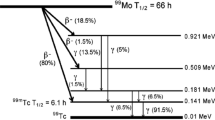Abstract
The hydrolytic products of manganese carbide Mn7C3 are hydrogen and a number of paraffins of the series CH4, C2H6, C3H8, etc., whose concentrations characteristically decrease with increasing number of carbon atoms in the hydrocarbon molecule. A radioanalytical method applied after Mn7C3 hydrolysis by tritium, oxide has revealed that an analogous series of olefins in trace concentrations is formed as well. It has been confirmed that the sum of the concentrations of hydrocarbons higher than C4 corresponds to the trend of the series. A stoichiometric and structurally consistent radical mechanism of Mn7C3 hydrolysis is proposed as derived from the composition of the hydrolytic products. The initial components of the radical reactions could be CH ¨2 and CH ·3 radicals. The statisical and combinatorial aspects of the mechanism are also discussed.
Similar content being viewed by others
References
H. MOISSAN, C. R. Acad. Sci., 116 (1893) 349.
H. MOISSAN, Ann. Chim. Phys., 9 (1896) 286.
E. MÜLLER, H. BARCK, Z. Anorg. Allg. Chem., 129 (1923) 321.
L. I. TOPIASHVILI, Izv. Akad. Nauk SSSR, Met. Toplivo, 6 (1962) 49.
W. R. MYERS, W. P. FISHEL, J. Am. Chem. Soc., 67 (1945) 1962.
S. HILPERT, J. PAUNESCU, Ber. Deut. Chem. Ges., 46 (1913) 3479.
F. FISHER, F. BANGERT, Brennstoff-Chem., 10 (1929) 261.
L. T. DOMASEVICH, B. V. FENOTSKA, S. P. GORDIENKO, I. I. TIMOFEYEVA, S. M. KARALNIK, A. V. KOVAL, T. YA. KOSOLAPOVA, Karbidy Splavy Ikh Osnove, G. V. SAMSONOV (Ed.), Naukova Dumka, Kiev 1976. pp 44–49.
B. HÁJEK, P. KAREN, V. BROŽEK, Coll. Czech. Chem. Commun., (in print).
R. BENZ, J. F. ELLIOT, J. CHIPMAN, Met. Trans., 4 (1973) 1449.
R. W. DYCK, R. TAYLOR, D. G. BOASE, At. Energy Can. Ltd, AECL Rep. 4917 (1975).
M. J. BRADLEY, L. M. FERRIS, Inorg. Chem., 1 (1962) 683.
A. BENADIK, H. BENADIKOVA, Coll. Czech. Chem. Commun., 35 (1970) 915.
J.-P. BOUCHAUD, Ann. Chim. (Paris), 2 (1967) 353.
V. I. NOVIK, I. N. TARAN, Izv. Akad. Nauk SSSR Neorg. Mater., 13 (1977) 1013.
Author information
Authors and Affiliations
Additional information
Part XVIII of the series Studies on Hydrolyzable Carbides. Part XVII: Collect. Czech. Chem. Commun., (in print).
Rights and permissions
About this article
Cite this article
Brožek, V., Hájek, B., Karen, P. et al. Verification of the interstitial carbide hydrolysis mechanism by a radioanalytical method. J. Radioanal. Chem. 80, 165–172 (1983). https://doi.org/10.1007/BF02517659
Received:
Issue Date:
DOI: https://doi.org/10.1007/BF02517659




